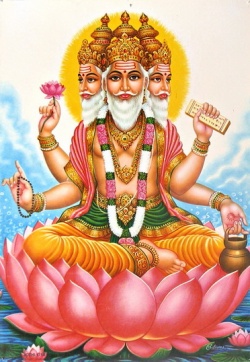Brahma in the Pali Canon
Brahma is among the common gods found in the Pali Canon. Brahma (in common with all other devas) is subject to change, final decline and death, just as are all other sentient beings in samsara (the plane of continual reincarnation and suffering). In fact there are several different Brahma worlds and several kinds of Brahmas in Buddhism, all of which however are just beings stuck in samsara for a long while. Sir Charles Eliot describes attitudes towards Brahma in early Buddhism as follows:
There comes a time when this world system passes away and then certain beings are reborn in the "World of Radiance" and remain there a long time. Sooner or later, the world system begins to evolve again and the palace of Brahma appears, but it is empty. Then some being whose time is up falls from the "World of Radiance" and comes to life in the palace and remains there alone. At last he wishes for company, and it so happens that other beings whose time is up fall from the "[[World] of Radiance]]" and join him. And the first being thinks that he is Great Brahma, the Creator, because when he felt lonely and wished for companions other beings appeared. And the other beings accept this view. And at last one of Brahma’s retinue falls from that state and is born in the human world and, if he can remember his previous birth, he reflects that he is transitory but that Brahma still remains and from this he draws the erroneous conclusion that Brahma is eternal.
